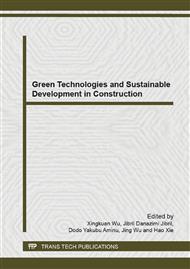[1]
Technical Report No. 55 (TR55), Design guidance for strengthening concrete structures using fiber composite materials, The Concrete Society, Camberley, (2012).
Google Scholar
[2]
ACI Committee 440 (ACI 440. 2R-08), Guide for the design and construction of externally bonded FRP systems for strengthening concrete structures, American Concrete Institute, (2008).
DOI: 10.14359/51700867
Google Scholar
[3]
fib Bulletin 14, Task Group 9. 3, Design and use of externally bonded fiber reinforced polymer reinforcement (FRP EBR) for reinforced concrete structures, Switzerland, (2001).
DOI: 10.14359/5660
Google Scholar
[4]
J. Schlaich, K. Schäfer, and M. Jennewein, Toward a consistent design of structural concrete, PCI j., vol. 32, pp.74-150, (1987).
DOI: 10.15554/pcij.05011987.74.150
Google Scholar
[5]
W. Teo and Y. Hor, Analytical truss models for prediction the shear strength of FRP strengthened reinforced concrete members, FRPRCS11, Joaquim Barros & José Sena-Cruz (Eds), UM, Guimarães, (2013).
Google Scholar
[6]
A. Mofidi and O. Chaallal, Shear strengthening of RC beams with EB FRP: Influencing factors and conceptual debonding model, J. Comp. Constr., vol. 15, pp.62-74, (2011).
DOI: 10.1061/(asce)cc.1943-5614.0000153
Google Scholar
[7]
Z. Zhang and C. -T. T. Hsu, Shear strengthening of reinforced concrete beams using carbon-fiber-reinforced polymer laminates, J. Comp. Constr., vol. 9, pp.158-169, (2005).
DOI: 10.1061/(asce)1090-0268(2005)9:2(158)
Google Scholar
[8]
J. F. Chen and J. G. Teng, Shear capacity of FRP-strengthened RC beams: FRP debonding, Constr. Build. Mater., vol. 17, pp.27-41, (2003).
DOI: 10.1016/s0950-0618(02)00091-0
Google Scholar
[9]
A. Khalifa, W. Gold, A. Nanni, and A. M.I., Contribution of externally bonded FRP to shear capacity of RC flexural members, J. Comp. Constr., vol. 2, pp.195-202, (1998).
DOI: 10.1061/(asce)1090-0268(1998)2:4(195)
Google Scholar


